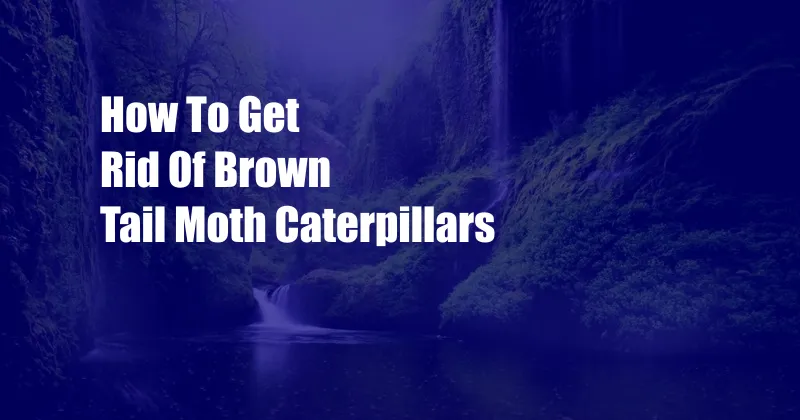
How to Effectively Eradicate Brown Tail Moth Caterpillars
As a nature enthusiast, I’ve encountered my fair share of fascinating insects. One that stands out is the brown tail moth caterpillar, a species known for its distinctive markings and the severe skin irritation it can cause upon contact. If you’ve come face-to-face with these critters, you know the urgency to rid yourself and your surroundings of them. Here’s a comprehensive guide to help you effectively eliminate brown tail moth caterpillars:
In the realm of insects, the brown tail moth caterpillar reigns as a formidable adversary, leaving behind a trail of discomfort for those who cross its path. Its presence can transform peaceful outdoor spaces into discomfort zones, making it essential to understand the means to effectively combat these pests.
Mechanical Removal: A Proven Technique
Mechanical removal is a time-honored approach to eliminating brown tail moth caterpillars. It entails physically removing the caterpillars from infested areas using various methods, each offering its own advantages. Handpicking may be feasible for small-scale infestations. Carefully grasp the caterpillars, ensuring you avoid direct contact with their hairs, and dispose of them promptly in a sealed container.
For larger infestations, vacuuming provides a more efficient solution. Utilize a vacuum cleaner with a HEPA filter to trap caterpillars, preventing the spread of their irritating hairs. Thoroughly vacuum carpeted surfaces, furniture, and any other areas where caterpillars may lurk. Remember to empty the vacuum cleaner contents into a sealed bag and dispose of them far away from your living space.
Chemical Control: A Measured Approach
Chemical control measures offer an alternative to mechanical removal, providing a potent means of eliminating brown tail moth caterpillars. However, it’s crucial to approach this method with caution, strictly adhering to safety guidelines and the instructions provided on the pesticide label. To minimize environmental impact and avoid harm to beneficial insects, carefully select a pesticide specifically labeled for brown tail moth caterpillar control.
When applying chemical treatments, prioritize spot applications directly to areas where caterpillars are present. Avoid spraying on windy days to prevent drift and potential harm to non-target organisms. Follow all safety precautions and wear appropriate protective gear, including gloves, long sleeves, and eye protection. To further enhance safety, consider using a pesticide sprayer with a wand extension, enabling you to maintain a safe distance while treating infested areas.
Biological Control: Harnessing Nature’s Power
Biological control offers a more environmentally friendly approach to managing brown tail moth caterpillar populations. This method involves introducing natural predators or pathogens that specifically target and control the pest. One effective biological control agent is Compsilura concinnata, a parasitic fly that lays its eggs on brown tail moth caterpillars. Upon hatching, the fly larvae feed on and eventually kill the caterpillars.
Another promising biological control agent is Bacillus thuringiensis (Bt), a bacterium that produces a toxin specifically toxic to caterpillars. Bt can be applied to affected areas, where it is ingested by caterpillars and disrupts their digestive system, ultimately leading to their demise. These biological control measures not only provide a sustainable and targeted approach to pest management but also help preserve the ecological balance of your environment.
FAQ on Brown Tail Moth Caterpillars
- Are brown tail moth caterpillars poisonous?
Yes, brown tail moth caterpillars have venomous hairs that can cause severe skin irritation upon contact, resulting in symptoms such as itching, redness, and swelling.
- What are the health effects of brown tail moth caterpillar exposure?
Exposure to brown tail moth caterpillar hairs can trigger various health issues, including dermatitis, conjunctivitis, and respiratory problems, particularly in sensitive individuals.
- How can I prevent exposure to brown tail moth caterpillar hairs?
To avoid exposure, wear protective clothing such as long sleeves, pants, gloves, and a mask when in areas where brown tail moth caterpillars are present. Avoid touching or handling caterpillars, and keep pets away from infested areas.
- What should I do if I come into contact with brown tail moth caterpillar hairs?
If you encounter brown tail moth caterpillar hairs, remove contaminated clothing and wash the affected area thoroughly with soap and water. Apply hydrocortisone cream or calamine lotion to soothe skin irritation. In case of severe reactions, seek medical attention promptly.
- How can I get rid of brown tail moth caterpillars on my property?
Implement a comprehensive approach that combines mechanical removal techniques (handpicking or vacuuming), chemical control measures (using pesticides specifically labeled for brown tail moth caterpillar control), and biological control methods (introducing natural predators or pathogens).
Conclusion: Empowering You to Take Action
Empowering yourself with the knowledge of how to eliminate brown tail moth caterpillars is not only crucial for your well-being but also for the protection of your environment. By adopting the comprehensive strategies outlined in this article, you can effectively tackle infestations and prevent future encounters with these troublesome pests. Remember, proactive measures and ongoing vigilance will safeguard your surroundings and ensure a pest-free living space.
If you’re interested in learning more about brown tail moth caterpillars and effective control methods, consider exploring the resources provided by the National Pest Management Association and the Environmental Protection Agency. Their websites offer valuable information, including up-to-date research and guidance on safe and effective pest management practices.